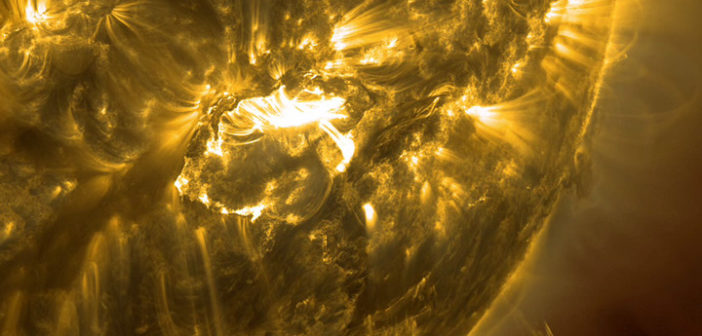Sophisticated machine-learning techniques may finally answer a question astronomers have pondered for decades: what makes the Sun launch solar flares?
Predicting and Pattern-Finding

Why study the causes of solar flares? Flares are just one example of how the Sun’s complex magnetic field interacts with its dynamic plasma environment. [NASA/GSFC/Solar Dynamics Observatory]
In a new study, a team led by Magnus Woods (Bay Area Environmental Research Institute and Lockheed Martin Solar and Astrophysics Lab) applied a machine-learning algorithm to ultraviolet solar spectra to identify signs that a solar flare is imminent — should any such signs exist.

A sample image of the Sun from IRIS, showing twisting structures dubbed “mini-tornadoes.” [NASA/IRIS/Pereira]
Spectral Signatures of Future Flares
Woods and collaborators used spectra from the Interface Region Imaging Spectrograph (IRIS) — an Earth-orbiting spacecraft dedicated to understanding the region of the Sun’s atmosphere in which the temperature increases sharply from a few thousand kelvin to millions of kelvin. The team selected three sets of observations for analysis: quiet Sun (no areas of enhanced magnetic fields), quiescent active region (enhanced magnetic fields but no solar flares), and flares. By comparing observations known to contain solar flares to those without, the team aimed to narrow in on spectral features that are uniquely associated with flares.
The team focused on the magnesium h and k lines, which are prominent features in the wavelength range monitored by IRIS. Their machine-learning technique pinpointed interesting behavior in these spectral lines; typically, the h and k lines are double peaked, but under the conditions that precede a solar flare — up to 40 minutes in advance — they retain only a single peak.
More To Learn

The two types of spectral signatures associated with pre-flare conditions. Individual profiles are in black and a representative profile is in orange. The data are reported in counts per second. [Adapted from Woods et al. 2021]
The team determined that the observed spectral features were associated with rising temperatures roughly 1,000 kilometers above the Sun’s surface. This suggests that the warning signs of solar flares are generated in this region, though more work is needed to confirm this result. The enormous wealth of solar spectral and magnetic data makes teasing out the fleeting signatures of solar flares a tall order, but this work makes it clear that machine learning can bring us a step closer to understanding the causes of solar flares.
Citation
“Unsupervised Machine Learning for the Identification of Preflare Spectroscopic Signatures,” Magnus M. Woods et al 2021 ApJ 922 137. doi:10.3847/1538-4357/ac2667

